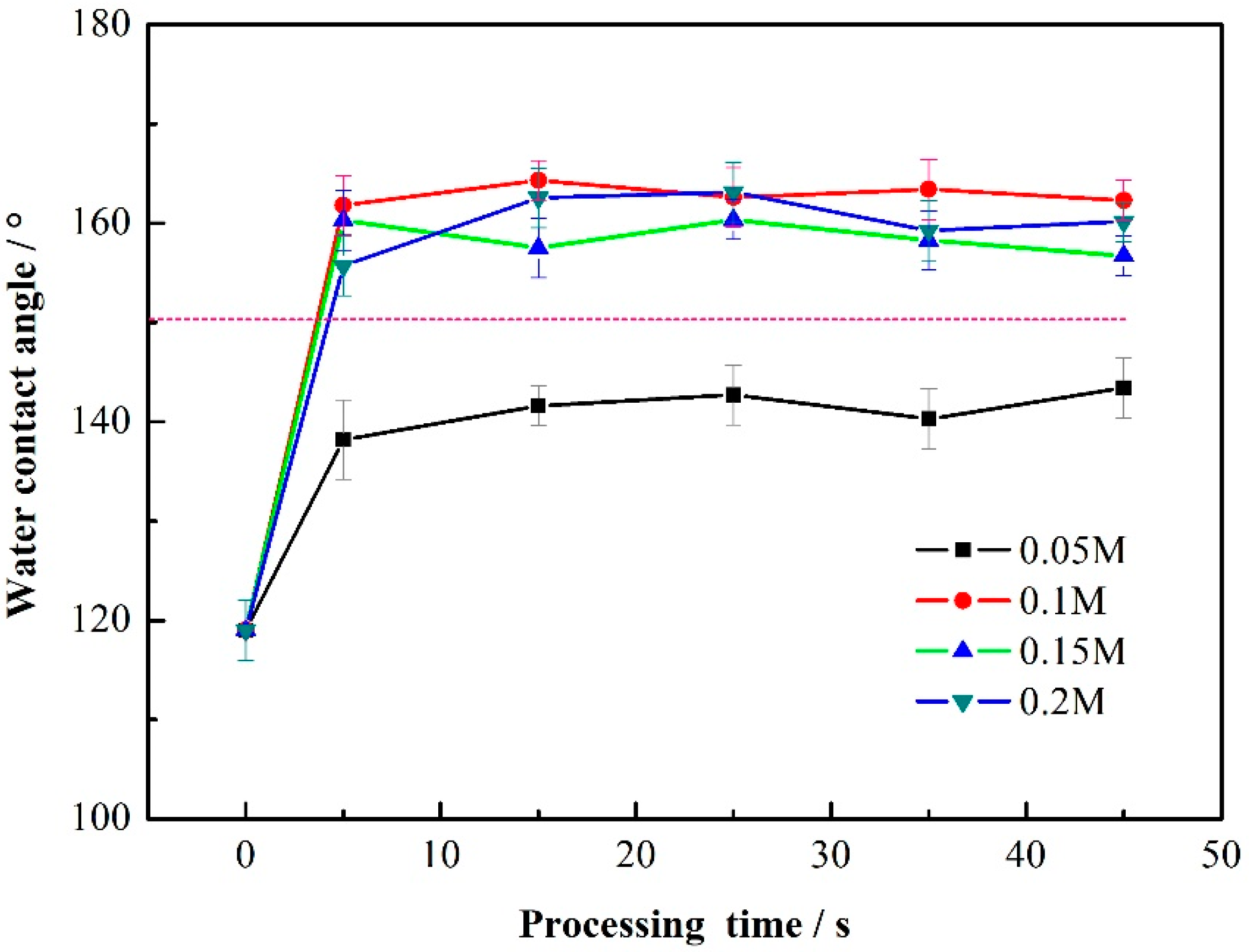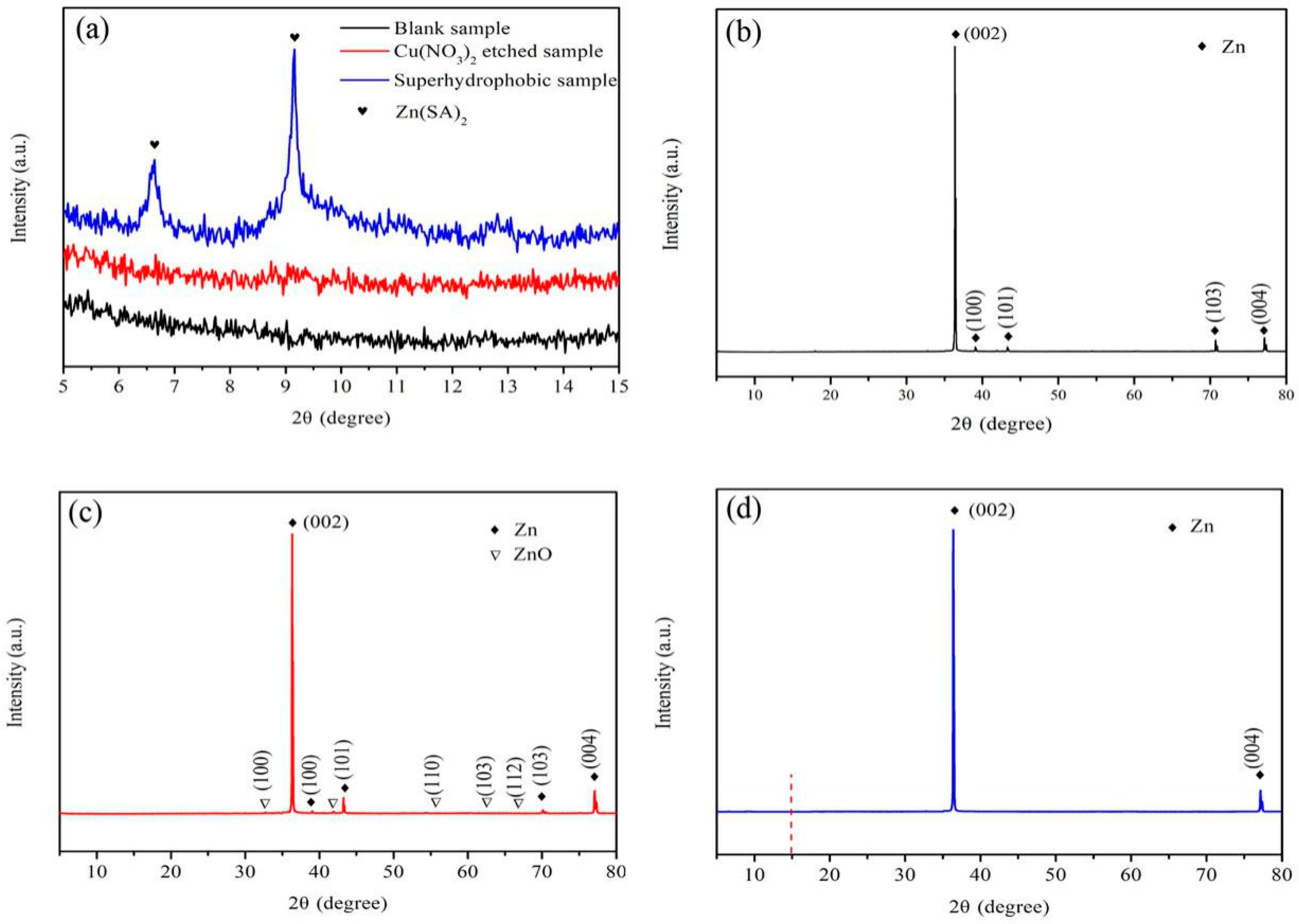Superhydrophobic Film on Hot-Dip Galvanized Steel with Corrosion Resistance and Self-Cleaning Properties
Abstract
:1. Introduction
2. Experiment
2.1. Materials
2.2. Sample Preparation
2.3. Characterization of Super-Hydrophobic Film
2.4. Electrochemical Test
2.5. Self-Cleaning Test
3. Results and Discussion
3.1. Surface Wettability
3.2. Surface Morphology
3.3. Surface Composition Analysis
3.3.1. EDS Analysis
3.3.2. XRD Analysis
3.3.3. FTIR Analysis
3.3.4. XPS Analysis
3.4. Theoretical Formation Mechanism for Super-Hydrophobic Surface
3.5. Corrosion Resistance of Super-Hydrophobic Film
3.6. Stability and Self-Cleaning Properties
4. Conclusions
Author Contributions
Funding
Conflicts of Interest
References
- Marder, A.R. The metallurgy of zinc-coated steel. Prog. Mater. Sci. 2000, 45, 191–271. [Google Scholar] [CrossRef]
- Liu, Y.W.; Wang, Z.Y.; Cao, G.W.; Cao, Y.; Huo, Y. Study on corrosion behavior of zinc exposed in coastal-industrial atmospheric environment. Mater. Chem. Phys. 2017, 198, 243–249. [Google Scholar] [CrossRef]
- Kartsonakis, I.A.; Stanciu, S.G.; Matei, A.A.; Hristu, R.; Karantonis, A.; Charitidis, C.A. A comparative study of corrosion inhibitors on hot-dip galvanized steel. Corros. Sci. 2016, 112, 289–307. [Google Scholar] [CrossRef]
- Aneja, K.S.; Bohm, S.; Khanna, A.S.; Bohm, H.L.M. Graphene based anticorrosive coatings for Cr(VI) replacement. Nanoscale 2015, 7, 17879–17888. [Google Scholar] [CrossRef] [PubMed]
- Wang, D.; Bierwagen, G.P. Sol–gel coatings on metals for corrosion protection. Prog. Org. Coat. 2009, 64, 327–338. [Google Scholar] [CrossRef]
- Su, H.Y.; Chen, P.L.; Lin, C.S. Sol–gel coatings doped with organosilane and cerium to improve the properties of hot-dip galvanized steel. Corros. Sci. 2016, 102, 63–71. [Google Scholar] [CrossRef]
- Figueira, R.B.; Silva, C.J.R.; Pereira, E.V. Hybrid sol–gel coatings for corrosion protection of hot-dip galvanized steel in alkaline medium. Surf. Coat. Technol. 2015, 265, 191–204. [Google Scholar] [CrossRef]
- Eduok, U.; Faye, O.; Szpunar, J. Recent developments and applications of protective silicone coatings: A review of PDMS functional materials. Prog. Org. Coat. 2017, 111, 124–163. [Google Scholar] [CrossRef]
- Eduok, U.; Szpunar, J. Bioinspired and hydrophobic alkyl-silanized protective polymer coating for Mg alloy. Prog. Nat. Sci. Mater. Int. 2018, 28, 354–362. [Google Scholar] [CrossRef]
- Eduok, U.; Szpunar, J.; Faye, O. Effect of benzothiazole biocide on SRB-induced biocorrosion of hot-dip galvanized steel. Eng. Fail. Anal. 2018, 93, 111–121. [Google Scholar] [CrossRef]
- Xia, F.; Jiang, L. Bio-Inspired, Smart, Multiscale Interfacial Materials. Adv. Mater. 2010, 20, 2842–2858. [Google Scholar] [CrossRef]
- Ahmad, Z.; Patel, F. Development of Novel Corrosion Techniques for a Green Environment. Int. J. Corros. 2011, 2012, 1–8. [Google Scholar] [CrossRef]
- Ahmad, Z.; Khan, A.U.; Farooq, R.; Saif, T. Hydrophobicity—A Green Technique for Enhancing Corrosion Resistance of Alloys. In New Trends in Alloy Development, Characterization and Application; InTechOpen: Rijeka, Croatia, 2015. [Google Scholar] [CrossRef]
- Wang, P.; Zhang, D.; Qiu, R.; Wu, J.; Wan, Y. Super-hydrophobic film prepared on zinc and its effect on corrosion in simulated marine atmosphere. Corros. Sci. 2013, 69, 23–30. [Google Scholar] [CrossRef]
- Kim, J.-H.; Mirzaei, A.; Woo Kim, H.; Sub Kim, S. Facile fabrication of superhydrophobic surfaces from austenitic stainless steel (AISI 304) by chemical etching. Appl. Surf. Sci. 2018, 439, 598–604. [Google Scholar] [CrossRef]
- Li, Y.; Liu, F.; Sun, J. A facile layer-by-layer deposition process for the fabrication of highly transparent superhydrophobic coatings. Chem. Commun. 2009, 19, 2730–2732. [Google Scholar] [CrossRef] [PubMed]
- Lu, S.; Chen, Y.; Xu, W.; Liu, W. Controlled growth of superhydrophobic films by sol–gel method on aluminum substrate. Appl. Surf. Sci. 2010, 256, 6072–6075. [Google Scholar] [CrossRef]
- Sun, J.; Zhang, F.; Song, J.; Wang, L.; Qu, Q.S.; Lu, Y.; Parkin, I. Electrochemical fabrication of superhydrophobic Zn surfaces. Appl. Surf. Sci. 2014, 315, 346–352. [Google Scholar] [CrossRef]
- Zheng, S.; Li, C.; Fu, Q.; Hu, W.; Xiang, T.F.; Wang, Q.; Du, M.P.; Liu, X.C.; Chen, Z. Development of stable superhydrophobic coatings on aluminum surface for corrosion-resistant, self-cleaning, and anti-icing applications. Mater. Des. 2016, 93, 261–270. [Google Scholar] [CrossRef]
- Young, T.J.; Jackson, J.; Roy, S.; Ceylan, H.; Sundararajan, S. Tribological behavior and wettability of spray-coated superhydrophobic coatings on aluminum. Wear 2017, 376–377, 1713–1719. [Google Scholar] [CrossRef]
- Xu, W.; Liu, H.; Lu, S.; Xi, J.M.; Wang, Y.B. Fabrication of Superhydrophobic Surfaces with Hierarchical Structure through a Solution-Immersion Process on Copper and Galvanized Iron Substrates. Langmuir 2008, 24, 10895–10900. [Google Scholar] [CrossRef] [PubMed]
- Pan, H.; Luo, F.; Lin, G.; Wang, C.W.; Dong, M.M.; Liao, Y.; Zhao, Q.Z. Quasi-superhydrophobic porous silicon surface fabricated by ultrashort pulsed-laser ablation and chemical etching. Chem. Phys. Lett. 2015, 637, 159–163. [Google Scholar] [CrossRef]
- Wu, Y.; Zhou, S.; Wu, L. Fabrication of Robust Hydrophobic and Super-Hydrophobic Polymer Films with Onefold or Dual Inverse Opal Structures. Macromol. Mater. Eng. 2016, 301, 1430–1436. [Google Scholar] [CrossRef] [Green Version]
- Yan, H.; Wang, Y.; An, Z.; Zhang, J.J.; Yang, H.X. The super-hydrophobic IR-reflectivity TiO2 coated hollow glass microspheres synthesized by soft-chemistry method. J. Phys. Chem. Solids 2016, 98, 43–49. [Google Scholar]
- Gao, R.; Wang, J.; Zhang, X.; Yan, H.J.; Yang, W.L.; Liu, Q.; Zhang, M.L.; Liu, L.H.; Takahashi, K. Fabrication of superhydrophobic magnesium alloy through the oxidation of hydrogen peroxide. Colloid Surf. A 2013, 436, 906–911. [Google Scholar] [CrossRef]
- Qing, Y.Q.; Yang, C.N.; Zhao, Q.Q.; Hu, C.B.; Liu, C.S. Simple fabrication of superhydrophobic/superoleophobic surfaces on copper substrate by two-step method. J. Alloy Compd. 2016, 695, 1878–1883. [Google Scholar] [CrossRef]
- Chen, C.; Yang, S.Y.; Liu, L.Y.; Xie, H.; Liu, H.; Zhu, L.X.; Xu, X.L. A green one-step fabrication of superhydrophobic metallic surfaces of aluminum and zinc. J. Alloy Compd. 2017, 711, 506–513. [Google Scholar] [CrossRef]
- Liu, B.J.; Wang, L.L.; Gao, Y.J.; Tian, T.Z.; Min, J.; Yao, J.L.; Xiang, Z.L. Synthesis and characterization of photoreactive silica nanoparticles for super-hydrophobic cotton fabrics application. Text. Res. J. 2015, 85, 795–803. [Google Scholar] [CrossRef]
- Zhong, Y.X.; Hu, J.; Zhang, Y.F.; Tang, S.W. The one-step electroposition of superhydrophobic surface on AZ31 magnesium alloy and its time-dependence corrosion resistance in NaCl solution. Appl. Surf. Sci. 2017, 427, 1193–1201. [Google Scholar] [CrossRef]
- Lu, Z.; Wang, P.; Zhang, D. Super-hydrophobic film fabricated on aluminium surface as a barrier to atmospheric corrosion in a marine environment. Corros. Sci. 2015, 91, 287–296. [Google Scholar] [CrossRef]
- Wang, P.; Zhang, D.; Qiu, R.; Hou, B.R. Super-hydrophobic film prepared on zinc as corrosion barrier. Corros. Sci. 2011, 53, 2080–2086. [Google Scholar] [CrossRef]
- Qu, M.; Zhang, B.; Song, S.; Chen, L.; Zhang, J.; Cao, X. Fabrication of Superhydrophobic Surfaces on Engineering Materials by a Solution-Immersion Process. Adv. Funct. Mater. 2010, 17, 593–596. [Google Scholar] [CrossRef]
- Guo, Z.; Zhou, F.; Hao, J.; Liu, W. Effects of system parameters on making aluminum alloy lotus. J. Colloid Interface Sci. 2006, 303, 298–305. [Google Scholar] [CrossRef] [PubMed]
- Wu, R.; Liang, S.; Pan, A.; Yuan, Z.; Tang, Y.; Tan, X.; Guan, D.; Yu, Y. Fabrication of nano-structured super-hydrophobic film on aluminum by controllableimmersing method. Appl. Surf. Sci. 2012, 258, 5933–5937. [Google Scholar] [CrossRef]
- Qian, B.; Shen, Z. Fabrication of superhydrophobic surfaces by dislocation-selective chemical etching on aluminum, copper, and zinc substrates. Langmuir ACS J. Surf. Colloids 2005, 21, 9007–9009. [Google Scholar] [CrossRef] [PubMed]
- Song, J.; Xu, W.; Liu, X.; Lu, Y.; Wei, Z.F.; Wu, L.B. Ultrafast fabrication of rough structures required by superhydrophobic surfaces on Al substrates using an immersion method. Chem. Eng. J. 2012, 211–212, 143–152. [Google Scholar] [CrossRef]
- Cao, L.; Liu, J.; Huang, W.; Li, Z.L. Facile fabrication of superhydrophobic surfaces on zinc substrates by displacement deposition of Sn. Appl. Surf. Sci. 2013, 265, 597–602. [Google Scholar] [CrossRef]
- Tao, N.; Xu, W.; Lu, S. Fabrication of superhydrophobic surfaces on zinc substrates. Appl. Surf. Sci. 2011, 258, 1359–1365. [Google Scholar]
- Qi, Y.; Cui, Z.; Liang, B.; Parnas, R.S.; Lu, H.F. A fast method to fabricate superhydrophobic surfaces on zinc substrate with ion assisted chemical etching. Appl. Surf. Sci. 2014, 305, 716–724. [Google Scholar] [CrossRef]
- Sarkar, D.K.; Saleema, N. One-step fabrication process of superhydrophobic green coatings. Surf. Coat. Technol. 2010, 204, 2483–2486. [Google Scholar] [CrossRef] [Green Version]
- Phankosol, S.; Sudaprasert, K.; Lilitchan, S.; Aryusuk, K.; Krisnangkura, K. Estimation of surface tension of fatty acid methyl ester and biodiesel at different temperatures. Fuel 2014, 126, 162–168. [Google Scholar] [CrossRef]
- Cheng, Y.Y.; Lu, S.X.; Xu, W.G.; Boukherroub, R.; Szunerits, S.; Liang, W. Controlled fabrication of NiO/ZnO superhydrophobic surface on zinc substrate with corrosion and abrasion resistance. J. Alloy Compd. 2017, 723, 225–236. [Google Scholar] [CrossRef]
- Huang, Y.; Sarkar, D.K.; Chen, X.G. Fabrication of Corrosion Resistance Micro-Nanostructured Superhydrophobic Anodized Aluminum in a One-Step Electrodeposition Process. Metals 2016, 6, 47. [Google Scholar] [CrossRef]
- Wertheim, G.K.; Campagna, M.; Hüfner, S. Density of states of Zn and β-Brass. Phys. Condens. Matter 1974, 18, 133–139. [Google Scholar] [CrossRef]
- Shirtcliffe, N.J.; Mchale, G.; And, M.I.N.; Perry, C.C. Wetting and wetting transitions on copper-based super-hydrophobic surfaces. Langmuir 2005, 21, 937–943. [Google Scholar] [CrossRef] [PubMed]
- Martines, E.; Seunarine, K.; Morgan, H.; Gadegaard, N.; Wilkinson, C.D.W.; Riehle, M.O. Superhydrophobicity and superhydrophilicity of regular nanopatterns. Nano Lett. 2005, 5, 2097–2103. [Google Scholar] [CrossRef] [PubMed]
- Singh, B.P.; Nayak, S.; Nanda, K.K.; Jena, B.K.; Bhattacharjee, S.; Besra, L. The production of a corrosion resistant graphene reinforced composite coating on copper by electrophoretic deposition. Carbon 2013, 6, 147–156. [Google Scholar] [CrossRef]












| Sample | Details |
|---|---|
| Blank sample | Samples without any treatment |
| Stearic acid (STA) modified sample | Samples only modified with stearic acid (STA) |
| Etched sample | Samples after immersion in Cu(NO3)2 aqueous solution without STA modification |
| Super-hydrophobic sample (SHS) | Samples etched by Cu(NO3)2 at optimum conditions and followed by STA modification |
| Sample | Ecorr (V) | icorr (A/cm2) | η (%) |
|---|---|---|---|
| Blank sample | ‒1.096 ± 0.01 | 4.802 × 10‒5 | - |
| Hydrophobic | ‒1.095 ± 0.02 | 1.615 × 10‒5 | 66.4 |
| Super-hydrophilic | ‒1.089 ± 0.02 | 7.652 × 10‒5 | - |
| Super-hydrophobic | ‒0.844 ± 0.03 | 1.632 × 10‒6 | 96.6 |
© 2018 by the authors. Licensee MDPI, Basel, Switzerland. This article is an open access article distributed under the terms and conditions of the Creative Commons Attribution (CC BY) license (http://creativecommons.org/licenses/by/4.0/).
Share and Cite
Li, C.; Ma, R.; Du, A.; Fan, Y.; Zhao, X.; Cao, X. Superhydrophobic Film on Hot-Dip Galvanized Steel with Corrosion Resistance and Self-Cleaning Properties. Metals 2018, 8, 687. https://doi.org/10.3390/met8090687
Li C, Ma R, Du A, Fan Y, Zhao X, Cao X. Superhydrophobic Film on Hot-Dip Galvanized Steel with Corrosion Resistance and Self-Cleaning Properties. Metals. 2018; 8(9):687. https://doi.org/10.3390/met8090687
Chicago/Turabian StyleLi, Chongchong, Ruina Ma, An Du, Yongzhe Fan, Xue Zhao, and Xiaoming Cao. 2018. "Superhydrophobic Film on Hot-Dip Galvanized Steel with Corrosion Resistance and Self-Cleaning Properties" Metals 8, no. 9: 687. https://doi.org/10.3390/met8090687





